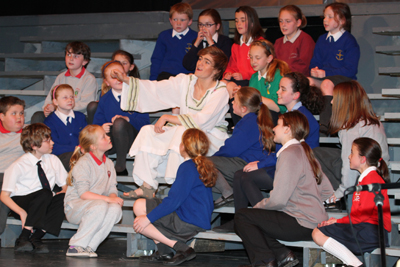Caruso and the Monkey House Trial & Joseph and the Amazing Technicolor Dreamcoat
Reviewed by George Fleeton

The arts in Down have no apparent immunity against the broader crises in the arts in general, and particularly with reference to the reception afforded to the performing arts.
Case-in-point: at the matinée performance of Caruso and the Monkey House Trial (Down Arts Centre, October 21) – the most dynamic one-man show seen in these parts in ages – there were just ten paying customers.
Exception-which-proves-the-
Mexican actor-tenor Ignacio Jarquin held that earlier Sunday afternoon audience spellbound as he recounted an embarrassing incident, from Enrico Caruso’s life in New York in 1906, by which he was accused of pinching a lady’s bottom at Central Park zoo, and the subsequent trial put both his impeccable reputation, and his career as the world’s greatest operatic tenor, in to a dark place.
Jarquin’s interpretation of that incident, his pitch perfect singing of snatches of Caruso’s repertoire at the Metropolitan Opera from that period, his evocation of multiple characters, including the monkey, were dramatically severe, demanding of total attention from the audience, on a stage with only a draped table, a stool and a banana, but this was acting, and singing, that took responsibility for the integrity of performance and, in the eight years of writing these reviews, I struggle to remember covering anything to surpass it – in this theatrical sub-genre, that is (although Philippa Urquhart’s reading of The Turn of the Screw, in April 2006, or David Calvitto’s self-reflective The Event, in April 2010, come close).
Barack Obama doppelgänger Ignacio Jarquin acted and sang his way through this historical footnote humorously and vividly, exquisitely dressed, mannered and coiffed and, towards the end, he still managed to take the unadorned top C in Rodolfo’s Che gelida manina from Puccini’s La bohème, Act 1.
The crises in the arts are undeniable, jobs in the sector are being dispensed with, any disposable income normally set aside for tickets, often at rock bottom prices, is being unprecedentedly squeezed, and, while private sector funding for performance arts has become more elusive, such subsidies are even more essential today than yesterday, in order to ensure that the fate of the dinosaurs does not befall the sometimes amazing, low budget, local arts’ provisions which we have been traditionally proud to support in this particular District.
The trains may no longer serve Downpatrick but the light at the end of the tunnel has not been turned off – yet.
* * *
Speaking of amazing segues nicely on to the St Patrick Choral Society Youth Theatre’s production of Joseph and the Amazing Technicolor ® Dreamcoat (seen on October 26).
The Society is in its 51st year but this was my first ever visit to one of their shows, accompanied by my 11 year old rookie scribe.
Joseph’s Dreamcoat (West End, 1973) was sire to only a handful of significant Lloyd Webber/Rice through-composed musicals that have literally enwebbed enthusiastic global audiences ever since: shows as diverse as Jesus Christ Superstar and Evita -and The Wizard of Oz which may have, just last year, somewhat healed the 34 year old rift between Lloyd Webber and lyricist Tim Rice.

Plato, 2,400 years ago, wrote in one of the Dialogues in his Republic that music gives soul to the universe, wings to the mind, flight to the imagination, charm to sadness, life to everything – music, he concluded, was the essence of order.
Much more recently Miles Davis, iconic trumpeter and composer, said that music is best heard in the moment in which it is performed; that’s when music is truly alive.
None of this ancient and modern empiricism was absent from the Choral Society’s production of the Dreamcoat.
Robust set, lighting, and costumes (not always flattering), nuanced direction (both on stage, and in the pit – piano, bass guitar, standard percussion, flute and saxophone), scintillating choreography, a choir of 22 primary school children, a junior ensemble of nine Wives, and 14 teen-age principals all drew draughts of inspiration from a tradition going back five decades, and all of this conspired to educate, entertain and inform a capacity audience (some parked on swathes of free-standing seating) which cheered their kith and kin to the rafters of the Great Hall.
Invidious as it would be to single out a show-stopper, a key-note performance, some things which helped to define the success of the production, Mark McMullan’s Elvis the Pharaoh Presley’s pastiche was spot on and, if it didn’t necessarily hit all the right notes in the right order, it was infectiously delivered.
But the revelation of the evening, as singer, actress, storyteller and one-girl Greek chorus, was Courtney Burns, whose grasp of what was going on around her showed a maturity in self-assurance and stage craft beyond her years.
As my apprentice reviewer commented: the show, the whole show and nothing but the show was overwhelming.
George Fleeton writes independently on arts and culture.
His production, Spring and Love, a recital of light classical music, with Jenny Bourke mezzo and Anna Cashell violin, will be given in Down Arts Centre on February 17.

























